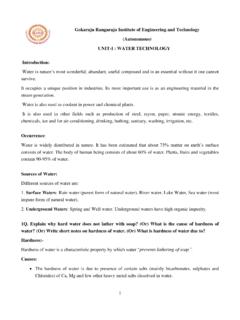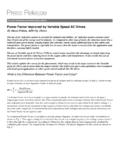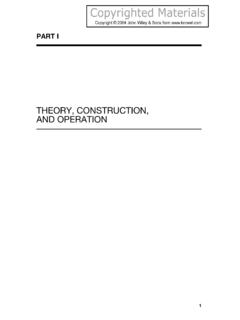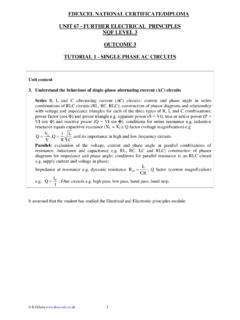Transcription of BASIC ELECTRICAL ENGINEERING - GRIET
1 BASIC ELECTRICAL ENGINEERING Madhuri GOKARAJU RANGARAJU INSTITUTE OF ENGINEERING AND TECHNOLOGY (Autonomous) Index: 1..1 2. Ohm s 3. KVL, .4 4. Nodes,Branches& 5 5. Series elements & Voltage 6. Parallel elements & Current 7. Star-Delta 8. Independent Sources ..9 9. Dependent 10. Source Transformation:..13 11. Review of Complex 12. Phasor Representation:..19 13. Phasor Relationship with a pure 14. Phasor Relationship with a pure 15. Phasor Relationship with a pure 16. Series and Parallel combinations of 17. Series and parallel connection of 18. Mesh 19. Nodal 20. Average, RMS 21. R-L Series 22. R-C Series 23. R-L-C Series 24. Real, reactive & Apparent 25. Power 26. Series 27. Parallel 28. Thevenin s 29. Norton s 30. Superposition 31. Maximum Power Transfer 32. Reciprocity 33. Single Phase 34. Single Phase Induction 35. DC GOKARAJU RANGARAJU INSTITUTE OF ENGG AND TECHNOLOGY (AUTONOMOUS) ACADEMIC YEAR 2014-15, Semester-I/II BASIC ELECTRICAL ENGINEERING (BEE) Sub code: GR14 Regulation L T P C 3 2 0 4 PreRequities : Fundamental in ENGINEERING Mathematics and Physics Course Objectives: BEE ( BASIC Electric ENGINEERING ) is common to first year branches of UG ENGINEERING (expect BT).
2 At the end of the course the student is expected to 1. Know the fundamental of ELECTRICAL ENGINEERING and practical. 2. Practical implementation of fundamental theory concepts. Course Outcomes : 1. Students will learn strong basics of ELECTRICAL ENGINEERING and practical implementation of ELECTRICAL fundamentals. 2. Students will learn different applications of commonly used ELECTRICAL machinery UNIT 1: BASIC Laws: Ohm s law, Kirchhoff s voltage and current laws, Nodes-Branches and loops, Series elements and Voltage Division, Parallel elements and Current Division, Star-Delta transformation, Independent sources and Dependent sources, source transformation. UNIT 2: AC Fundamentals-I: Reviews of Complex Algebra, Sinusoids, phasors, Phasor Relations of circuit elements, Impedance and admittance, Impedance Combinations, Series and Parallel combination of Inductors and capacitor, Mesh analysis and Nodal analysis . UNIT 3: AC Fundamental-II: RMS and average values, Form factors, Steady state Analysis of series, Parallel and Series Parallel combination of R,L,C with Sinusoidal excitation, Instantaneous power, Real power, Reactive power and Apparent power, concept of Power factor, Frequency.
3 UNIT 4: Network Theorems and Resonance: Superposition theorem, Thevinin s theorem, Nortorn s theorem, Maximum Power Transfer Theorem, Reciprocity theorem, Resonance in ELECTRICAL circuits: Analysis of series and parallel Resonance. UNIT 5: Fundamentals of ELECTRICAL Machines: Construction, Principle, Operation and Application of (i) Single phase Transformer (ii) Single phase Induction motor (iii) DC Motor. TEXTBOOK: 1. Fundamentals of ELECTRICAL Circuits by Charles , Mattew , Tata McGraw Hill company. Reference Book: theory(Analysis and Synthesis) by A. Chakrabarti-Dhanpat Rai&Co. Theory by 3. Circuit Theory by Sudhakar and ShyamMohan. Machines-I by UNIT 1: BASIC Laws: Ohm s law, Kirchhoff s voltage and current laws, Nodes-Branches and loops, Series elements and Voltage Division, Parallel elements and Current Division, Star-Delta transformation, Independent sources and Dependent sources, source transformation. OHM S LAW At constant temperature, the current flowing through a conductor is directly proportional to the potential difference( ) in volts across the two ends of the given conductor and inversely proportional to the resistance (R) in ohms ( ) between the ends of the same conductor.
4 / In all practical problems of ELECTRICAL calculations, it is assumed that the temperature rise is within limits, so that ELECTRICAL properties such as insulation and conduction properties of the . = / = = / = = A Solved Examples: 1. An ELECTRICAL iron carrying 2A at 120V. Find resistance of the device? Soln : =( / )=120/2= 60 2. The essential component of a toaster is an ELECTRICAL element (a resistor) that converts ELECTRICAL energy to heat energy. How much current is drawn by a toaster with resistance 12 at 110V? Soln: A 3. In the given circuit, calculate current I, the conductance G and the power P? Soln: i= = 6mA G= = mhos P = VI = I R = 180mW 4. A voltage source of 20 Sin t V is connected across a 5K resistor. Find the current through the resistor and power dissipated. Soln: = = 4 ( ) , = = 80 ( ).
5 5. A resistor absorbs an instantaneous power of 20 Cos2t mW when connected to a voltage source V=10 Cost V. Find I and R. Soln: I = 2 Cos(t) mA R = 5K . KIRCHOFF S CURRENT AND VOLTAGE LAWS ( KCL and KVL) KIRCHOFF S CURRENT LAW : KCL states that the total current entering a junction is equal to the total current leaving the junction. (or) The algebraic sum of the currents at the junction (node) will be zero. At node n, ( 2+ 3+ 4) =( 1+ 6+ 5) Or 2+ 3+ 4 1 6 5=0. KIRCHOFF S VOLTAGE LAW: KVL is based on the law of the law of conservation of the energy, states that the algebraic sum of voltage drops in a closed loop is zero. 1 + 2 + 3 = 1 + 2 + 3 = 0 {Flow of currents in loop is assumed +ve from higher potential to lower potential in elements and +ve from lower to higher potential in Sources} Problem: 1. Write KCL and KVL equations for the given circuits: 2.
6 Find the current measured in galvanometer shown in the wheatstone s bridge. Soln: A (C to A) 3. Determine the voltage across 1 resistor in the given circuit. Soln: V 4. 5. From the given circuit, find the voltage across ab, cb, and db. Soln: = = 0 = NODES, BRANCHES AND LOOPS: Network is an interconnection of elements or devices, circuit is a network providing one or more closed paths. A BRANCH represents a single element such as voltage source or a resistor. A NODE is the point of connection of two or more branches. A LOOP is any closed path in a circuit. A network with b branches, l loops and n nodes should satisfy the theorem of n/w topology. = + 1 Solved examples: 1. Determine the number of branches and nodes in the circuit shown. Identify which elements are in series and which are in parallel. Soln: Branches 4; Nodes 3: 10V source and 5 resistance are connected in series. The combination is in parallel with 6 resistance and 2A source.
7 2. A bulb rated 110V , 60W has to be operated from a 230V supply. Show the arrangement. Soln: = = ; = 120/ = 3. A 50 and a 100 rheostats are each rated at 100W. What is the maximum voltage that may be applied without causing overheating of either rheostat (i) when they are connected in series and (ii) when they are in parallel. Soln: SERIES ELEMENTS AND VOLTAGE DIVISION Two or more elements are in series if they are cascaded or connected sequentially and consequently carry the same current. The equivalent resistances of any number of resistors connected in series is the sum of the individual resistances. Three resistances R1,R2,R3 are connected in series. The current passing through all the elements connected in series is same, I. In the above figure1, according to KVL, sum of voltage drops in a closed loop is zero. =0 ( , , are drop across , , ) = + + = ( + + )..(1) In figure2, =.
8 (2) From equations (1) and (2) = + + Therefore voltage applied divides across the series connected elements. Applications of Series Circuits : 1. Decorative serial sets, number of bulbs with low voltage ratings connected in series across existing rated voltage. 2. Voltage distribution or tapping. Solved Examples: 1. Find for the given circuit. Soln : 2. Find and in the given circuit. Calculate the power dissipated in 3 . Soln : = , = 4 , = . 3. Find , , , and power dissipated in 12 and 40 . Soln : = 5 , = 10 , = , = 250 , = , = . PARALLEL ELEMENTS AND CURRENT DIVISION Two or more elements are in parallel if they are connected to the same two nodes and consequently have the same voltage across them. The parallel connected elements have the same voltage across them. = = ..(1) From KCL, at node A, = + ..(2) From (1) , = / + / / = 1/ + 1/ or = ( )/( + ) The equivalent resistance of the parallel resistors is equal to the product of their resistances divided by their sum.
9 = + G : conductance The equivalent conductance connected in parallel is the sum of their individual conductances. From (2) , = = ( ) ( )/ = ( )/( ( + ) Therefore = ( )/( + ) and 2 = ( )/( + ) Solved Examples: 1. Two batteries of 24V and 20V with internal resistances of and respectively are connected in parallel across a load of 4 . Calculate (i) the current supplied by each battery and (ii) voltage across the load. Soln: and , 2. Two coils are connected in parallel and a voltage of 200V is applied to the terminals. The total current taken is 25A and the power dissipated in one of the coils is 1500W. What is the resistance of each coil? Soln: and 3. Three impedances = (5+ 5) , = 8 and = 4 are connected in series to an unknown voltage source V. find I and V, if the voltage drop across is . Soln: = + + = I = A V= 150 0 V. STAR DELTA TRANSFORMATION Star connection and delta connection are the two different methods of connecting three BASIC elements which cannot be further simplified into series or parallel.)
10 The two ways of representation can have equivalent circuits in either form. Assume some voltage source across the terminals AB. = + = ( + )/( + + ) Therefore + = ( + )/( + + )..(1) Similarly + = ( + )/( + + )..(2) + = ( + )/( + + )..(3) Subtracting (2) from (1) and adding to (3) , = /( + + )..(4) = /( + + )..(5) = /( + + )..(6) A delta connection of can be replaced by an equvivalent star connection with the values from equations (4),(5),(6). Multiply (4)(5) ; (5)(6) ; (4)(6) and then adding the three we get, + + = /( + + ) Dividing LHS by gives , by gives , by gives . = ( + + ) / = ( + + ) / = ( + + ) / Solved Examples : 1. Obtain the star connected equivalent for the given delta circuit. Soln : 2. For the bridge network shown, determine the total resistance seen from the terminals AB using star-delta transformation. Soln: 3. Calculate the voltage across AB in the network and indicate the polarity of the voltage using star-delta conversion.












